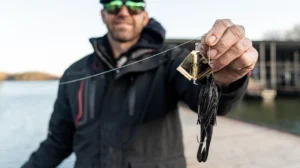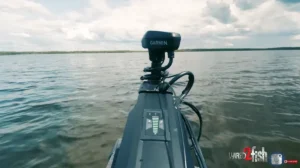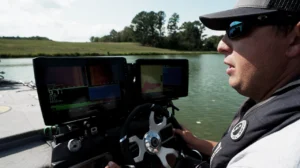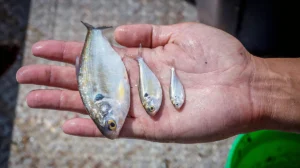If you were to drop a bass angler on a totally unfamiliar lake and tell them to catch a bass, I’d bet a pretty penny they’d head to the nearest boat dock. These man-made structures are bass magnets throughout much of the year, but with the allure comes one major downfall: Everyone fishes them.
The lakes I primarily fish have thousands of boat docks and each and every Saturday morning, boats line the shorelines and begin the weekly game of merry-go-round. The fish see the same baits in the same places and before you know it, the fishing pressure gets to them and they stop biting.
Here are some tips to catch bass others are leaving behind.
Move with the water
When springtime rolls around, heavy rains often follow. These rains don’t necessarily have the same biological impact on bass behavior as they would in the winter or summer seasons, but they can heavily dictate the water levels of your fishery. Although a large majority of the bass are shallow in the spring, fluctuating water can make them move just far enough to mess with your head. They’re still in the area, but adjustments are essential.
As a general rule-of-thumb, bass move with the water level. When the water level is rising, they’re likely positioned close to the shoreline. If the water is dropping, you’ll find them on nearby breaklines on what I call “secondary cover”—or cover that’s several feet away from the shoreline.
With that being said, don’t be afraid to fish in inches—yes, inches—of water when targeting docks in high water; it’s absolutely amazing how shallow the bass will live. I’ll target walkways and the intersection of walkways and shoreline with spinnerbaits, vibrating jigs and topwater frogs. The high water may inhibit you from skipping a jig underneath the dock itself, but these particular baits displace a lot of water and attract attention, which can draw the bass from under the dock to attack your offering.
Low water levels can really play tricks on your mind. The docks are often several feet out of the water, leaving a beautiful—and easy—casting lane for anglers to skip both jigs and soft plastics like a pro. But remember; the bass move with the water level, so they may not be in those sexy-looking dark spots that are so tempting.
In this situation, targeting the fronts of boat docks can be an incredibly effective way to catch bass. On sunny days, I’ll pitch soft plastics and jigs to the front posts and adjacent brush piles planted by landowners and on cloudy days, I’ll make long casts parallel to the front posts with a shallow crankbait or spinnerbait.
While there are no absolutes in fishing, remember this: Fluctuating water usually won’t make your fish move to an entirely different area. Your boat just might be sitting on top of them.
Don’t overlook the walkways
When many of us fish boat docks, we’re drawn to the deepest, darkest areas of shade we can find. This can certainly be a great way to catch bass, but always make an effort to fish the walkways connecting the main platform of the dock to the shoreline. When you find them here, it’s very easy to pattern and can lead to an awesome day of fishing.
Largemouth bass love to spawn underneath the walkways of docks. They have a little cover over their heads to protect themselves from airborne predators and when the eggs hatch, the cover also serves as suitable protection for their fry. While the other anglers quickly fish the easiest and most accessible parts of the dock, make an effort to slide into the shallows and target these areas.
Of course, jigs and soft plastics are great choices for any type of dock fishing. But I’ve also had a lot of sucess on prop baits, buzzbaits and topwater frogs. I’ll make casts perpendicular to the walkways and allow my bait to land on the opposite side to avoid splashing down right on top of the fish. After waiting a few seconds for the ripples to die down, I’ll begin my retrieve and more times than not, I’ll see the bass wake towards my bait before they attack it.
Not only are walkways easy to pattern throughout a fishery, but they also offer some vicious strikes. I see it this way: The bass are up there for one of two reasons. Either they’re guarding a bed or looking to actively feed. In both situations, they’re extremely aggressive and territorial.
Keep your distance
If you’re fishing in especially dirty or muddy water, distance isn’t too big of a deal. But in water with a foot or more of clarity, positioning your boat further from the dock can pay huge dividends.
I don’t think trolling motors spook bass when they’re on a “constant” setting. But I certainly believe bass will spook—I’ve seen it quite often—when you’re frequently starting and stopping your acceleration. You could be fishing a dock with two 6-pounders underneath it, but if you’re too close, you won’t have a prayer of catching them.
When I’m pitching and flipping docks in relatively clear water, I prefer to use a 1/2-ounce jig or a 3/16-ounce shaky head because the weight and hook of these two lures act as one cohesive unit. You can make a hard skip cast from 25 feet away and there’s no weight sliding up and down your line and inhibiting your accuracy.
I love to fish Texas rigs on docks as much as the next guy, but they just don’t skip very well. Even with a pegged weight, you’ll still have a certain degree of movement on a long cast and risk having that big tungsten weight knock against the dock. Bass are very aware of their surroundings, so anytime you hit a dock with your bait, you drastically decrease your chances of catching a bass.
If you’re not comfortable with skipping heavier baits, a wacky-rigged stick worm or weightless floating worm on spinning tackle will work as well. Accurate casts are of the utmost importance, so just use something you can skip confidently. If you can’t get your bait to the fish, you’re not going to catch them.
It’s all about contact with moving baits
I’m certainly not suggesting you slam your high-dollar crankbait into the nearest dock post. But colliding your moving baits with the dock throughout your retrieve is an effective way to get reaction bites from otherwise lethargic bass.
When the bass are active, there are times you can put a lure within 3 or 4 feet of a dock and expect a bite. But when things get tough and the fish are in a negative mood, I like to put the proverbial ball in their court. In other words, I prey on their reactionary instincts.
It’s the same thing as if I randomly tossed a baseball to you; you’re going to try to catch it.
Whenever you’re fishing crankbaits, spinnerbaits, buzzbaits or vibrating jigs around docks, make a concerted effort to knock the bait off of the dock posts. Whether you have to tune your crankbait to one side or choose your casting angles more carefully, this approach will absolutely help you catch more bass.
A lot of anglers fly down a stretch of docks chucking and winding some sort of reaction bait; the bass are accustomed to seeing that. But when you can get your lure to knock into posts or ladders and dart in and out of the overhangs, you’re showing them something they rarely see.
Skirt the perimeter
You can have some good days flipping and pitching docks in cloudy conditions—I feel like I need to say that before I make somebody mad or something. But most often, cloudy conditions make bass more prone to roam the shallows. They don’t necessarily need the shade of a dock, so they take it as an opportunity to cruise around and do some serious feeding.
Don’t get into a flipping and pitching robot mode when you’re fishing docks; they’re not always going to be under them. If it’s raining, cloudy and nasty, there could be a major reaction bait bite happening and you might be totally missing out.
In lowlight conditions, consider playing the numbers game. Instead of pitching a single dock for 5 or 10 minutes, try picking up a fast-moving lure and skirting the perimeter of boat docks. Make a cast down each side and across the front and move on to the next target. Not only can this help you quickly develop a productive pattern, but it also allows you to put your bait in front many more bass, hence the term “numbers game”.





![[VIDEO] Greg Hackney’s Formula for Post-Spawn Bass Success](https://www.wired2fish.com/wp-content/uploads/2025/05/Hackney_Post-Spawn_Bass-300x169.webp)
![[VIDEO] Scanlon’s Guide for Stained Water Spawning Bass](https://www.wired2fish.com/wp-content/uploads/2025/05/scanlon-jig-300x169.webp)
![[VIDEO] Seth Feider’s Prespawn Jig Pattern Explained](https://www.wired2fish.com/wp-content/uploads/2025/04/prespawn-jig-300x169.webp)









